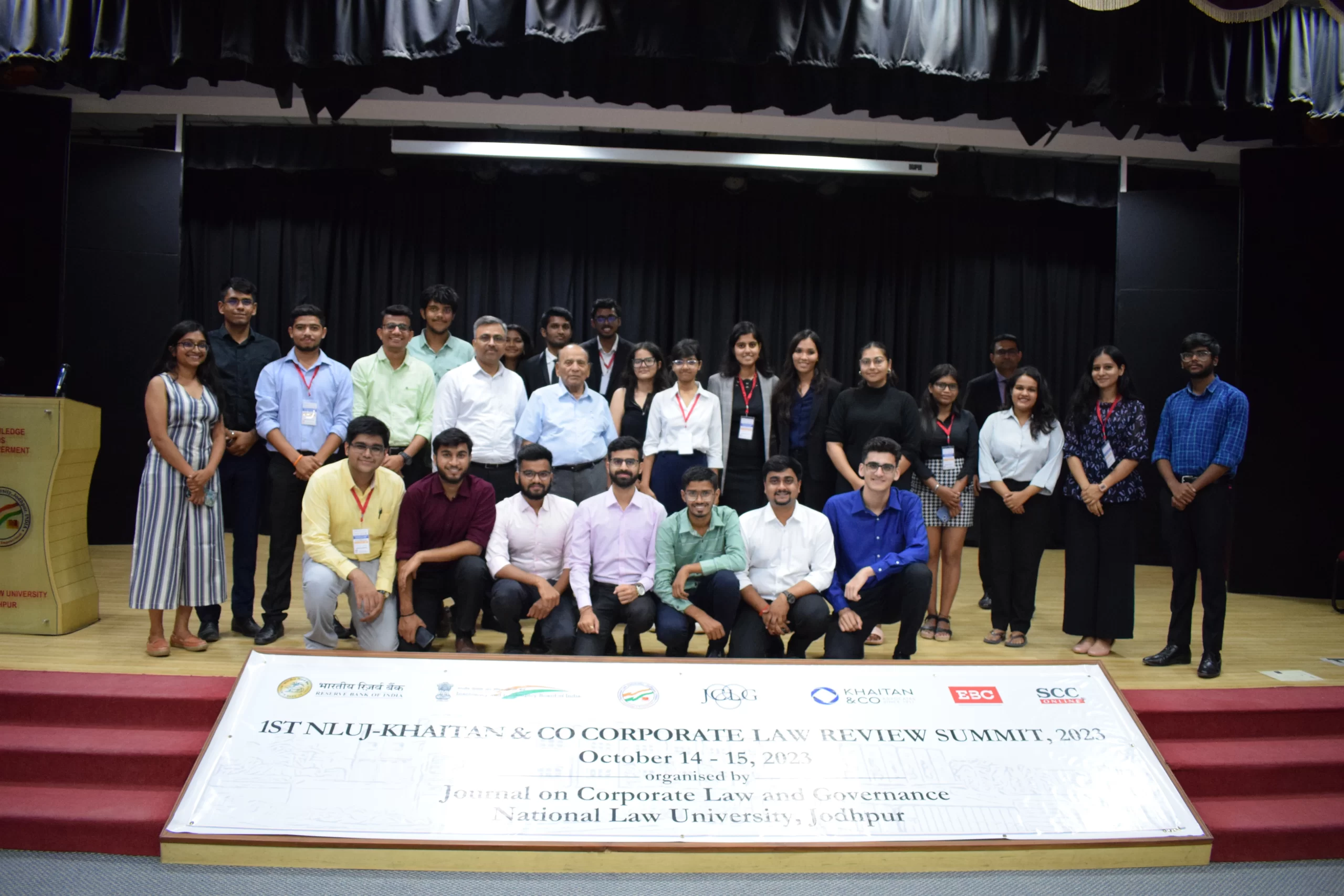
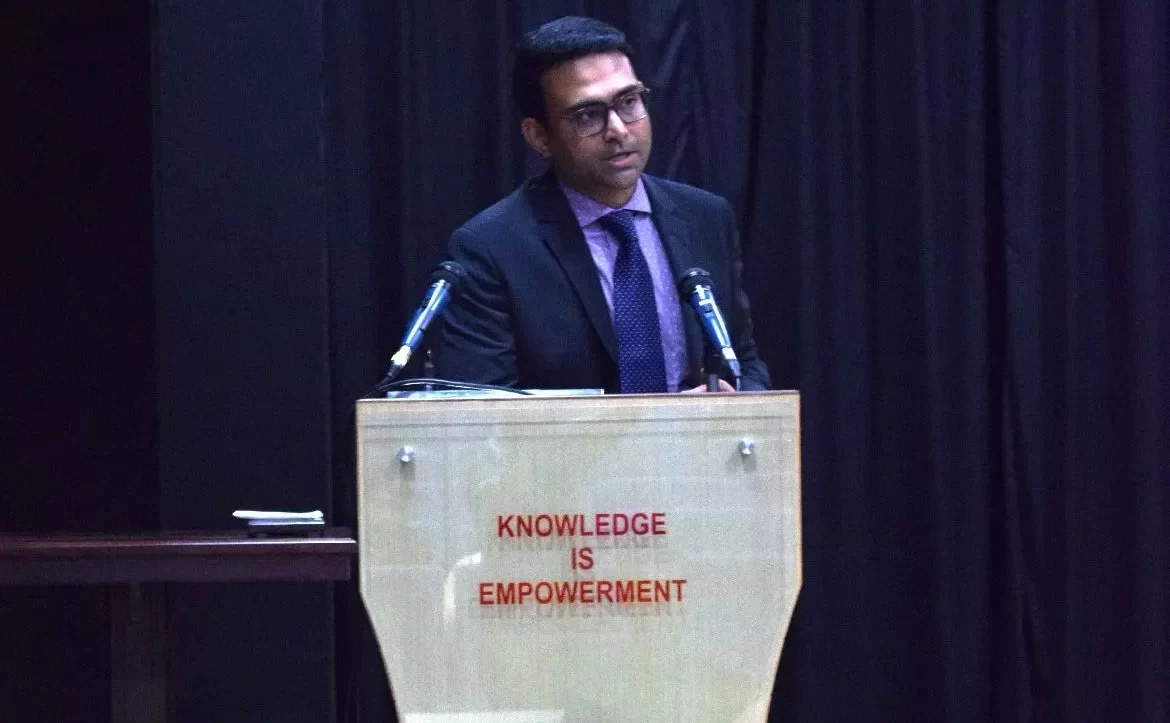
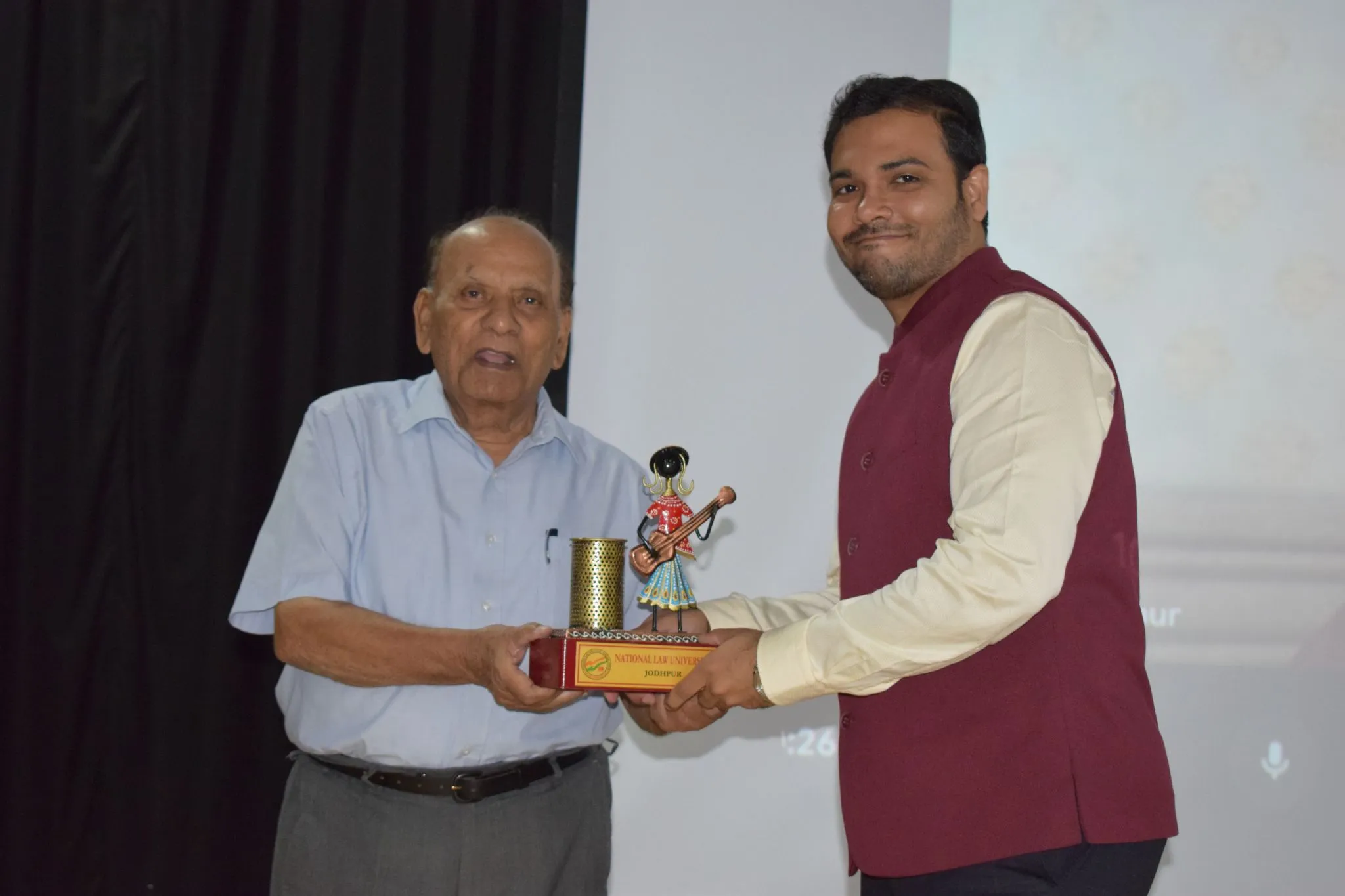
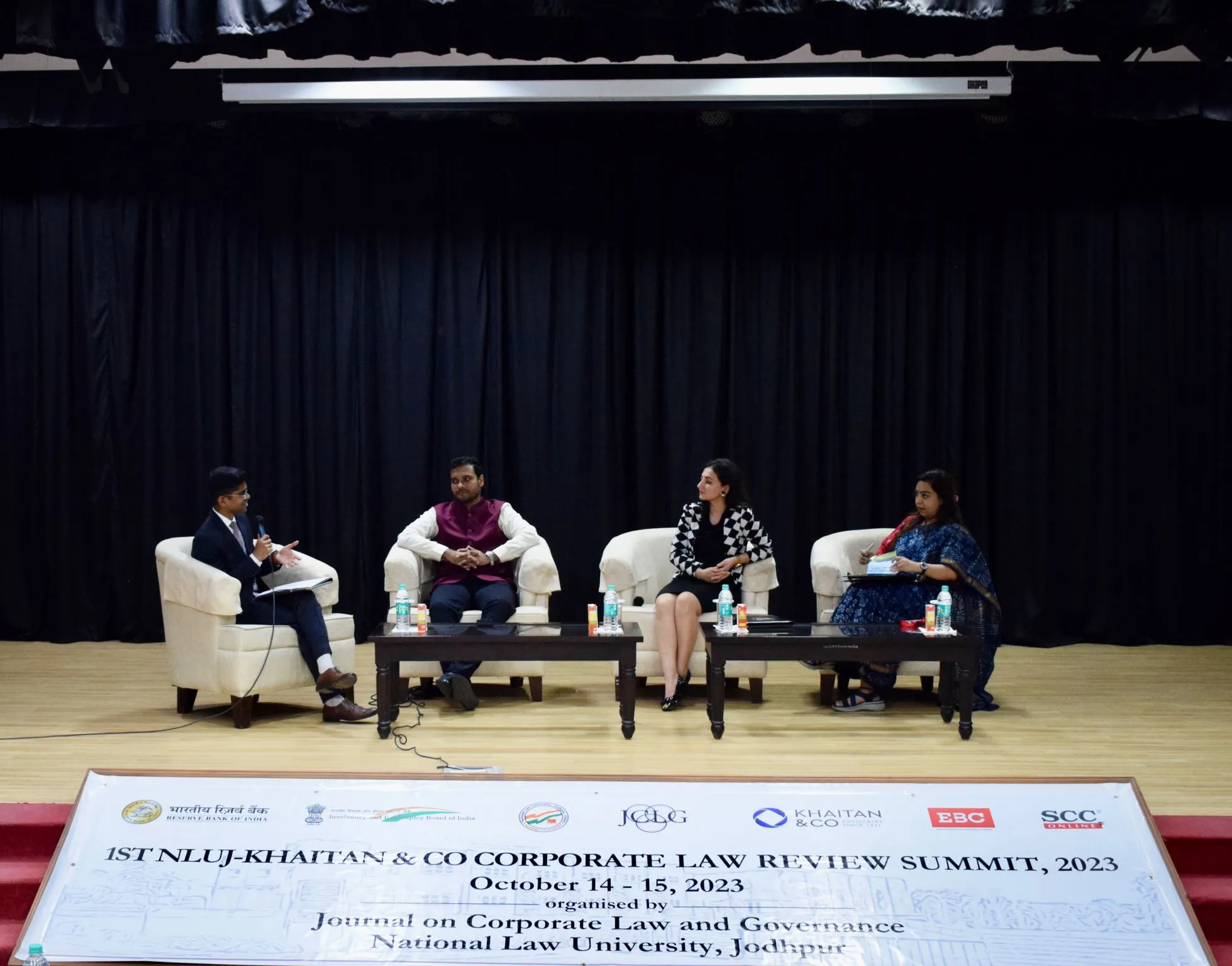
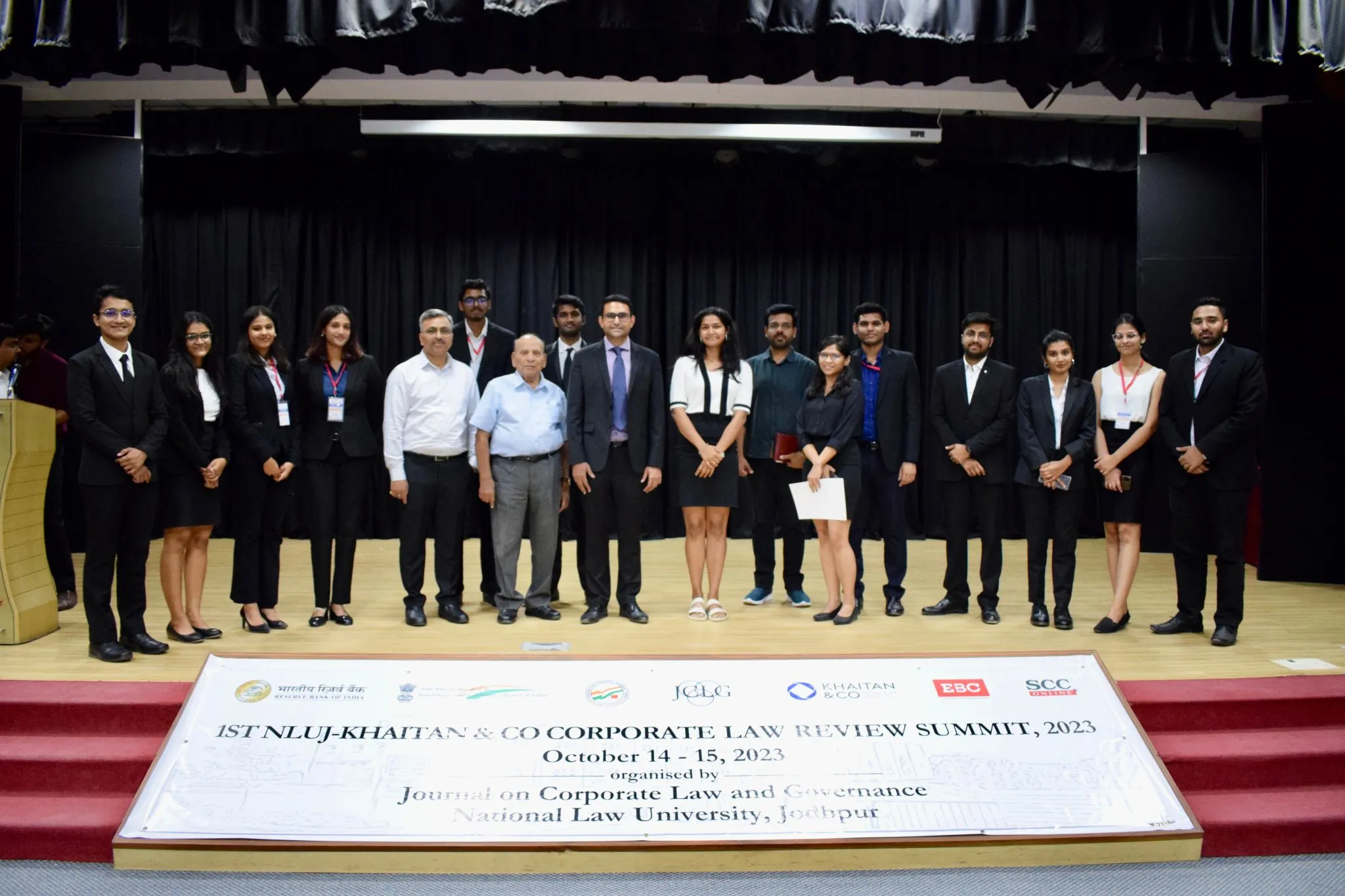
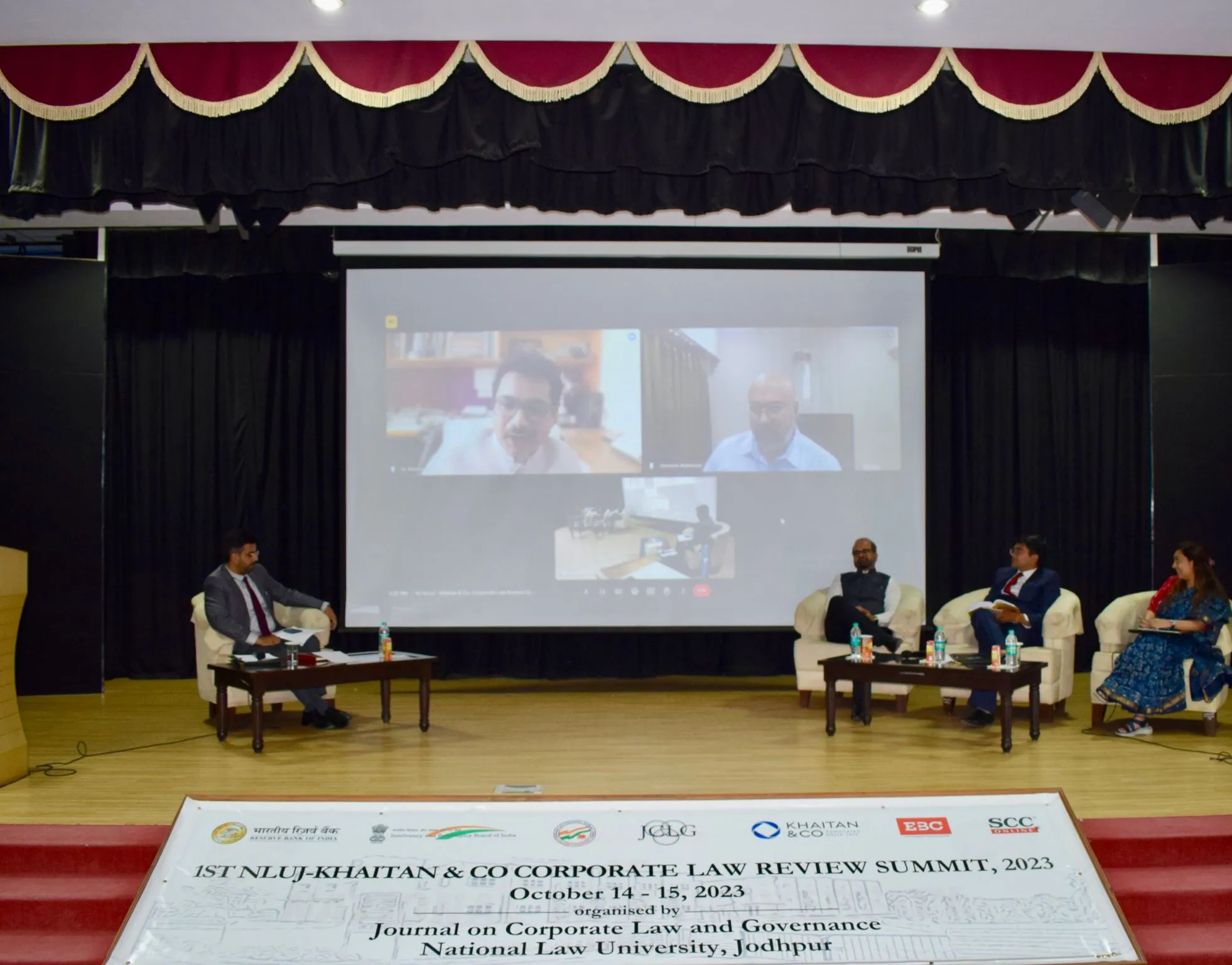
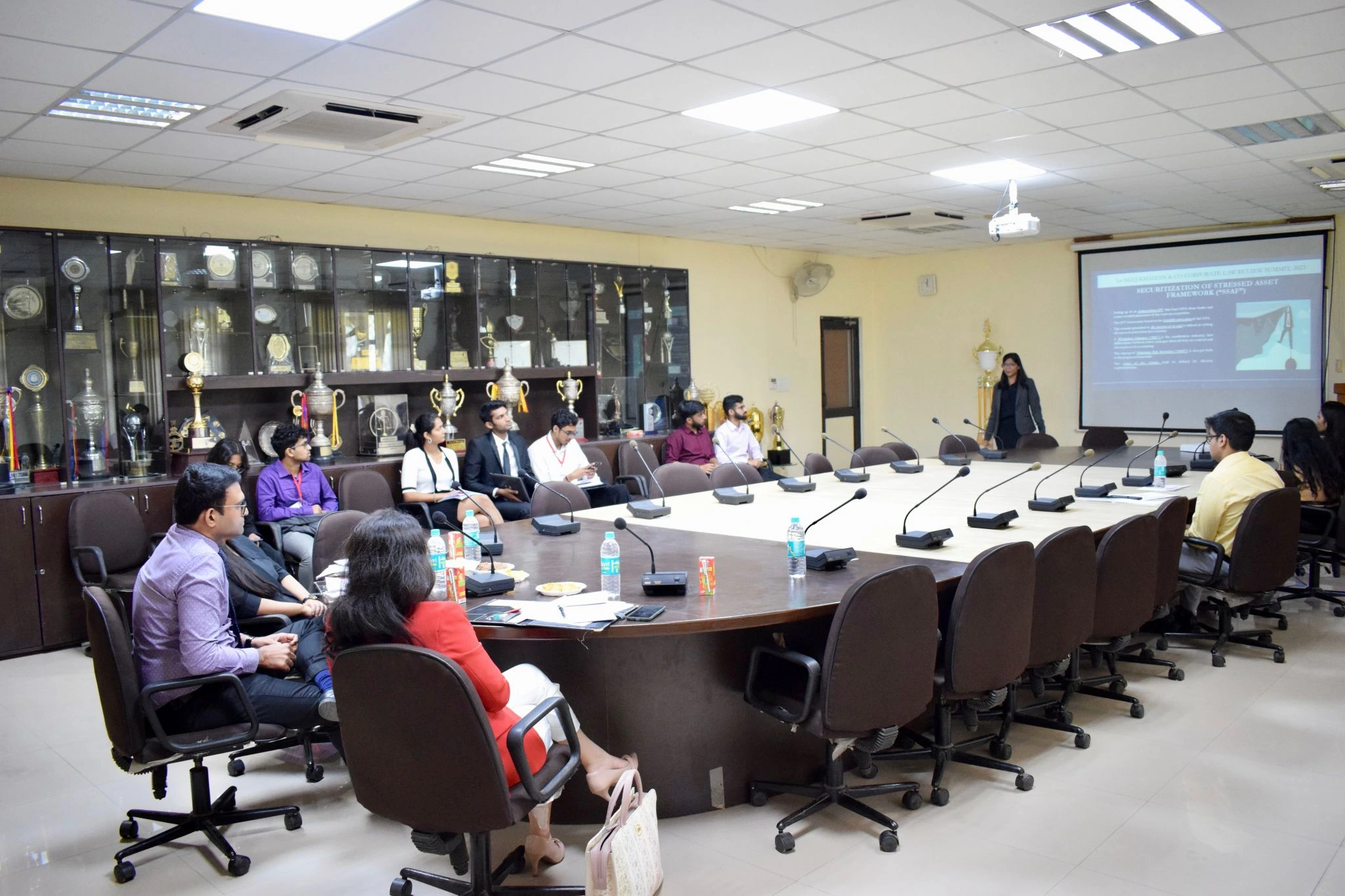
The 1st NLUJ-Khaitan & Co Corporate Law Review Summit, 2023, was organized by the Journal on Corporate Law and Governance at National Law University, Jodhpur, on October 14-15 2023.
The event was sponsored by the Reserve Bank of India, in collaboration with the Insolvency and Bankruptcy Board of India (IBBI), and Khaitan & Co, along with SCC Online – Eastern Book Company as the knowledge partners for the summit.
The summit featured a panel discussion with erudite personalities in the field of corporate governance on the first day, i.e., October 14. It was followed by paper presentations by 10 shortlisted candidates out of 120 enthusiastic participants who submitted their insightful academic articles.
This summit served as a crucial platform for diverse perspectives and valuable insights to converge, bridging the theory-practice gap and deepening our understanding of corporate law, a subject that significantly influences our academic voyage.
Inaugural Ceremony
The inaugural ceremony of the summit commenced with the lighting of the lamp by our esteemed guests and the honorable Dean, Professor Dr. IP Massey. The Dean then welcomed the guests and emphasized the need for such collaborations to further the holistic development of students.
Following this, the Editors-in-Chief, Ms. Deesha Reshmi and Mr. Ojasav Chitranshi reflected on the rigorous process of candidate selection and expressed gratitude to the participants, guests, and attendees for making the Summit possible.
Next, Dr. Manoj Kumar Singh, Faculty Incharge and Chief Editor of the Journal, highlighted the importance of summits like these, which demonstrate the university’s dedication to fostering academic excellence and pushing the boundaries of our understanding. Such summits encourage the exchange of ideas and knowledge, going beyond their academic value to guide the country’s economics through times of change.
Subsequently, the Vice Chancellor, Professor Dr. Harpreet Kaur, congratulated everyone on the occasion and discussed emerging challenges in the field of corporate law, including those associated with the fintech companies and prepackaged insolvency in MSMEs.
This was followed by a keynote address from Mr. Santosh Kumar Shukla, Executive Director of IBBI, who emphasized the importance of research, referring to it as the ‘lifeblood of institutions.’ He comprehensively elucidated the incorporation of the Securities and Exchange Board of India (SEBI) in 1992, the Competition Act in 2002 and introduction of the Insolvency and Bankruptcy Code (IBC) in 2016 as pillars of freedoms to start, compete and exit the business respectively. He elaborated on how traditionally, we have been trained to believe that insolvency is a stigma, but in reality it has been inherent in our culture. He also remarked that liquidation is not killing the business, it is a way of resolution, just like IBC which is a code of resolution. To quote him, “the Court has made it clear time and again that the debtors’ paradise is lost, now the control is with creditors. It has brought about great behavioral change and default rates are going down.”
Panel Discussion 1
TOPIC
Regulation of Fintech Platforms: Balancing Innovation & Protection
PANELISTS
Mr. Khabeer Ahmed, Deputy General Manager, Reserve Bank of India; Ms. Vidushi Gupta, Partner Mumbai office, Khaitan & Co; Dr. Surbhi Kapur, Assistant Professor, Jindal Global Law School.
Moderator: Mr. Sarthak Mishra, Assistant Professor, Faculty of Law, National Law University, Jodhpur.
Mr. Khabeer Ahmed:
Mr. Ahmed discussed the significant changes in the RBI’s approach to digital lending since 1995. Initially, the RBI tightly regulated various aspects of credit-related matters. However, as credit growth surged, the RBI began to deregulate to prevent asset bubbles. He also addressed how fintech companies entered the market, and post-COVID, digital lending platforms experienced substantial growth, particularly targeting informal and marginalized sectors.
He highlighted the concerns that arose with rapid expansion, leading to about 2000-2500 cases per month related to digital lending platforms. In response, the RBI established a fintech department and regulatory sandbox mechanisms to facilitate public discourse. He further emphasized that the rise of predatory lending also resulted in suicides, prompting interactions with state governments, law firms, and law enforcement agencies. He noted that around 600 of the 1000 digital lending apps were operating without authorization, necessitating regulation.
To maintain a balance between macro financial stability, consumer protection, and innovation, he discussed how the RBI introduced digital lending guidelines. These guidelines aim to regulate the relationship between regulated entities and loan service providers, ensuring that banks remain central to lending while the RBI continues to regulate them.
He addressed the commercial wisdom of wealth maximization and the liberalization principle of profit maximization, raising questions about the role of self-regulation and consumer welfare. He stated that the RBI is considering self-regulatory organizations (‘SRO’) to address these issues, offering a platform for stakeholders to discuss policy issues and promote self-discipline among regulatory entities. He pointed out that multiple entities, including digital lending banks, NBFCs, and fintechs, are subject to RBI regulation, with the role of fintechs in the regulatory landscape being a point of contention.
He discussed how SROs play a crucial role in regulation, including pattern-regulation, soft-regulation, and self-regulation. He mentioned that the RBI is planning to issue an omnibus approval framework for recognizing SROs, allowing them greater autonomy. He underlined that the extent to which fintechs should be regulated remains a contentious issue, with regulatory guidelines depending on market evolution. He also stressed the importance of considering cultural alignment and information technology in regulating self-regulatory bodies.
He noted that challenges include the overarching jurisdiction of the Insolvency and Bankruptcy Code (IBC) over other laws and potential conflicts between regulators and the government. However, he mentioned that avenues for resolution, such as the Insolvency Law Committee, are being explored to address these issues.
Ms. Vidushi Gupta:
As a law firm partner with experience in bridging the gap between new industry players and regulatory bodies, Ms. Gupta provided insights on how fintech firms have evolved. They have transitioned from being largely unregulated in their early years to achieving a balance between liberalization and regulation.
She also emphasized the necessity of collaborations and mergers between established banks, which have the requisite customer base and resources, and fintech firms with innovative ideas and technological capabilities.
Regarding evolving laws on privacy and various regulatory requirements, she noted the importance of consent and transparency. She highlighted that in today’s world, banks often obtain implied consent from customers through the use of technology, which could potentially lead to issues in the future.
When discussing the future of fintech players, she expressed her belief that in a few years, we will witness better governance. There will be fewer new registrations of fintech companies, but they will be more sustainable in nature.
Dr. Surbhi Kapur:
Academician Dr. Surbhi Kapur remarked how essential it is to look at the societal impact of any measure that is to be taken to solve the challenges faced by the emerging fintech industry and the industry regulators. She emphasized on the need for striking a balance in regulation, somewhere between a hands-off and a status quo approach, with a focus on the well-being of those who are affected by it.
She also emphasized the need for collaboration to leverage the strengths of both banks and fintechs. She stated that the negotiation process between them should aim to ensure that each party benefits. Banks can gain knowledge of modern IT from fintechs, while fintechs should have the necessary resources for compliance.
She also raised concerns about the challenges that Insolvency Professionals may encounter when accessing data from fintech firms undergoing resolution. She proposed extending the pre-pack insolvency resolution process to fintechs.
On the point of transparency highlighted by the moderator, Dr. Kapur pointed out that established parameters and specific requirements must be established. Access to information should be equitable on both sides, consent mechanisms for customer data must be robust, and specific details, such as the source of funds, should be clearly disclosed. She remarked that with improved transparency and information flow, compliance can be enhanced.
Panel Discussion 2
TOPIC
Extending Pre-Packaged Insolvency Resolution Package beyond the MSMEs
PANELISTS
Mr. Abhishek Mukherjee, Partner, Mumbai office, Cyril Amarchand Mangaldas; Dr. Risham Garg, Associate Professor, National Law University, Delhi; Mr. Tahir Ashraf Siddiqui, Advocate on Record, Supreme Court of India; Dr. Surbhi Kapur, Assistant Professor, Jindal Global Law School; Dr. Santosh Kumar Shukla, Executive Director, IBBI.
Moderator: Dr. Anand Kumar, Assistant Professor, Faculty of Law at National Law University, Jodhpur.
Dr. Risham Garg:
Dr. Risham Garg noted the mixed impact of the Pre-pack Insolvency Resolution Process (‘PPIRP’). He highlighted the significance of MSMEs for India’s GDP and their vulnerability due to COVID’s economic impact, which necessitated a distinct resolution mechanism. He proposed that extending this model to other sectors could be efficient, but raised concerns about Section 29A of IBC. He re-emphasized that IBC’s objective is to balance stakeholders’ interests.
Regarding banks’ reluctance to adopt PPIRP, he suggested that sensitization and showcasing success stories could encourage banks to use it. The debtor-friendly nature of the process raises concerns about scrutiny for their decisions.
He also mentioned the Bankruptcy Law Reforms Committee (BLRC) and the debate surrounding the applicability of Section 29A in PPIRP cases. Clarity, transparency, access to information, and fairness of the process were emphasized as crucial.
Mr. Abhishek Mukherjee:
In agreement with Dr. Garg, Mr. Abhishek Mukherjee emphasized the purpose of the PPIRP and noted that very few PPIRPs have occurred, with even fewer receiving approval, which is not the desired outcome. He stressed the need for the legal community to advocate for PPIRPs to achieve their intended objectives and address current issues.
Regarding the application of Section 29A of the IBC in PPIRP cases, he remarked that in India, as we follow the debtor-driven approach, the applicability could be relaxed. While serious defaults like fraud should still apply, non-performing asset-related defaults could be less stringent in PPIRP cases.
He also commented on a two-layered process involving PPIRP admission and NCLT approval, recommending the adoption of a model similar to the US and UK, where debtors can file petitions without court involvement, thus reducing the NCLT’s role to approval processes. This change would streamline and expedite the PPIRP proceedings.
Mr. Santosh Kumar Shukla:
Mr. Shukla pointed out that the IBC has facilitated something the market may not be mature enough to handle and how the Supreme Court has, on numerous occasions, supported the Parliament’s stance.
Regarding the potential compromise of the financial creditor’s interests in favor of the operational creditor (OC) under the current regime, he reiterated that the objective of the law is value maximization. He remarked that even though only a few PPIRPs have been carried out, a qualitative analysis of these instances shows that no such compromise has occurred.
When discussing the expansion of PPIRP to other sectors beyond MSMEs, he mentioned that while it may be successful, it currently remains a policy decision on the part of the government, which could change in the future. He also emphasized the need for those making decisions regarding the resolution process to do so with courage and without external pressure.
Dr. Surbhi Kapur:
Dr. Kapur emphasized the concept of ‘fait accompli’ in legal discourse, particularly within the context of the Pre-Packaged Resolution Process, which promotes a stakeholder-centric approach. The report discusses the significance of the PPRIP and its impact on India’s economy, underscoring the need for careful implementation.
She also shed light on the IBC as a significant economic law since liberalization. However, she also discussed the challenges it poses for small businesses. A comprehensive approach is required, involving not only the IBBI but also banking regulators to ensure its success.
Dr. Surbhi suggested that banking regulators should introduce soft-touch regulations in the complex insolvency and bankruptcy ecosystem to streamline processes and align banks with the objectives of the IBC and PPRIP.
When suggesting key considerations for the policy framework, she recommended the inclusion of techno-economic feasibility assessments before determining haircuts in the resolution process, exploring the transplantation of legal practices from international standards, and categorizing companies based on their unique needs.
Dr. Kapur concluded by emphasizing that the PPRIP and IBC are crucial in India’s legal and economic landscape. Effective implementation requires thoughtful policies, cooperation between regulators and institutions, techno-economic assessments, legal practices from international sources, and company categorization. She believes this approach will enhance the legal ecosystem, benefiting India’s economic growth and stability.
Mr. Tahir Ashraf Siddiqui:
Mr. Siddiqui began by pointing out that the entire scheme involves everyone giving up something to gain something more, especially in the context of the IBC. Micro, Small, and Medium Enterprises (MSMEs), as small businesses, may not fully grasp the complexities of the IBC, including basic resolution plans and how to rescue their businesses.
In the IBC process, he stated that the adjudicating authority must confirm and appoint a new Insolvency Resolution Professional (IRP), providing a second chance for resolution. In the Corporate Insolvency Resolution Process (CIRP), corporate debtors often challenge the existence of debt, and creditors in countries like Singapore and the UK have more influence in deciding the fate of the business.
Mr. Siddiqui mentioned that the implementation of the IBC has been inconsistent, with a voluntary mechanism frequently preferred. This suggests that a voluntary approach, especially with reduced voting share, may enhance efficiency and efficacy, making it potentially more suitable for entities other than MSMEs.
He called for the dilution of Section 29A in the context of PPIRP, adopting a model where valuation is independent, similar to what is seen in the UK. This change could improve the chances of a successful resolution through this process.
Mr. Siddiqui emphasized the need to address concerns raised about instilling a culture of financial creditors being willing to accept haircuts. The law mandates payment of all confirmed operational debt, and stakeholders need to be sensitized, trained, and provided with guidelines. This transition should be process-based rather than individual-centric. The role of the Central Vigilance Commission (CVC) and public money deposited in financial institutions is discussed, and the need for objective criteria for demarcation is raised.
Finally, he acknowledged the challenge of differentiating between valuation methods for electronic data-heavy companies and traditional firms when implementing the IBC effectively.
PAPER PRESENTATION
The second day of the 1st NLUJ-Khaitan & Co Corporate Law Review Summit, 2023 featured paper presentations from short-listed candidates and the highly anticipated closing ceremony. The day kicked off with a warm welcome to our distinguished judges for the paper presentations, including Mr. Mohan VK, Deputy Legal Adviser at the Reserve Bank of India, Ms. Vidushi Gupta, Partner in M&A and private equity at Khaitan and Co, and Ms. Ruth Vaiphei, an Assistant Professor in the faculty of law at National Law University, Jodhpur. They set the stage before passing the microphone over to the eager participants.
Presentation 1: Securitization of Stressed Assets: A Half-Baked Bread for the Indian Market?
In their presentation, the presenter discussed the non-performing asset (NPA) market in India, which stands at 15 billion US dollars, highlighting the potential for stressed assets and foreign investors. In the presentation, it was pointed out that while the Gross Non-Performing Assets (GNPA) ratio has improved, it’s still a concern due to inefficient schemes for handling stressed assets. Stressed assets, which fail to provide promised principal, lead to NPAs, burdening the Indian economy. India’s recovery methods for NPAs include the Insolvency and Bankruptcy Code, 2016 (IBC), but there’s a need for alternative approaches outside the IBC framework, such as securitization because IBC focuses on resolution. The paper was divided into sections covering securitization, historical NPA recovery, the proposed SSAF, lessons from other countries, roadblocks in implementation, a suggestive framework for secured asset securitization, and conclusions about the scheme’s future. The presentation explored the proposed Securitization of Stressed Assets Framework (SSAF) by Reserve Bank of India (RBI) and discussed concerns about including standard assets and minimum risk retention.
2nd Presentation: Rightful Investors or a Rueful Fan Club? The Quandary of Regulating Community Stock Ownership Plans in India
The presenters discussed the growing popularity of Community Stock Ownership Plans (‘CSOP’) in India, driven by the startup wave and investment-based content. They explored the concept of CSOPs, tracing their historical roots and how they have evolved, particularly as a tool for startups to raise funds. They highlighted concerns about the balance of benefits between startups and retail investors, pointing out issues with CSOP agreements offered by platforms like Tyke Invest. The lack of clear regulation for CSOPs, especially regarding Stock Appreciation Rights (‘SAR’) for unlisted entities, was addressed. The consumer-investor’s position in this framework was discussed, emphasizing the lack of due diligence and clarity. The presentation proposed solutions, including amending the Companies Act to include unlisted securities, creating a regulatory mechanism for platforms like Tyke, and establishing entry barriers while balancing regulatory oversight. In conclusion, they emphasized the need for a well-defined framework for CSOPs to maintain investor confidence and promote fairness.
Presentation 3: Mindful Machines and Financial Wisdom: Navigating AI and FinTech’s Responsible Journey Towards Modern Banking
In this presentation, the transformative impact of Financial Technology (FinTech) and Artificial Intelligence (AI) in the banking sector was highlighted. The presenters covered how AI collaborates with banks to improve predictive modeling, customer experiences, and operational processes, while FinTech offers user-friendly tools for transactions. They also emphasized the potential risks related to data privacy and security, the need for strong regulatory measures to protect personal data, and stressed the importance of cybersecurity defenses, ethical AI use, and addressing biases in AI decision-making. The presentation underscored the importance of integrating data governance and ethical strategies to create a balanced and just technologically progressive future for the banking industry.
Presentation 4: Rethinking the Moratorium Clause Under IBC: An Anatomization of Aviation Insolvency
In this presentation, the presenters explored aviation insolvency and India’s strong preference for aircraft leasing. They argued that the IBC isn’t ideal for aviation insolvency. They examined how moratoriums affect leases and bank guarantees and analyzed the Cape Town Convention Bill, 2018. The presentation stressed the need for changes in handling aviation insolvency, especially concerning IBC’s Section 14(1)(d) and the IDERA process during a moratorium. The presenters advised financial creditors to include insolvency anticipation clauses and discussed the proposed ‘Protection and Enforcement of Interests in Aircraft Objects Bill, 2022.’ Balancing the waiting period and the CIRP period, aviation-specific IBC amendments, capital requirements for airlines, and AI in insolvency detection were suggested. The importance of balanced legislation was emphasized.
Presentation 5: Ushering SEBI’s Prudential Norms to Maturity: Clearing the Way for Central Counterparties’ Investment Policy
In their presentation, the presenters discussed global efforts to regulate clearing corporations after the 2008 Lehman Brothers Crash. They highlighted the Committee on Payments and Market Infrastructures’ twenty-four principles for regulators, with a focus on Principle 16 concerning clearing corporations’ investment exposures. They argued that SEBI’s regulatory approach in India has been inconsistent and insufficient, particularly in comparison to the European Union and the United States. The presenters noted that SEBI’s recent Consultation Paper on Prudential Norms falls short in addressing evolving Indian Capital Market risks and the challenges posed by pledged instruments. They made several recommendations, including the inclusion of municipal bonds and secure instruments, addressing pledging and hedging issues, and refining percentage caps on exposure via fixed deposits relative to the investee bank’s net value.
Presentation 6: Shining a Light on RBI NBFC P2P Guidelines: Evolving a Model of Development for P2P Lending Firms
In their presentation, the presenters discussed peer-to-peer (‘P2P’) lending as a significant alternative to traditional banking for loans. They explained that the RBI introduced NBFC P2P lending guidelines in 2017 to regulate registration and activities of P2P entities. The guidelines aimed to create fairness for lenders and borrowers while preventing P2P platforms from acting as shadow banks by limiting certain activities. However, the RBI noted that some platforms were not following these guidelines properly and that certain market practices were not adequately regulated. The presentation outlined the current P2P lending guidelines, discussed the RBI’s recent inquiry into NBFC P2P platforms, proposed potential guideline amendments, and advocated for mandatory winding down plans for P2P lending companies.
Presentation 7: A New Era of Digital Lending in India: Have the FinTech Players Become Compliant?
The presentation focused on digital lending’s potential to boost convenience and productivity for financial organizations. They highlighted the RBI’s “Guidelines on Digital Lending” from September 2022, discussing their impact on banks, NBFCs, and control mechanisms. The presentation also covered the clarification of the First Loss Default Guarantee (‘FLDG’) gray area by RBI in June 2023. It delved into the effects on FinTech companies, global trends, and consumer data protection. The guidelines were seen as a way to drive sustainable growth in lending, but potential FLDG limitations might prompt fintech companies to rethink their strategies. A case study assessed digital lending entities’ compliance with RBI regulations, concluding with suggestions for guideline improvement.
Presentation 8: Decoding the proposed amendment to UPSI: Equitable or Archaic?
In their presentation, the presenters discussed SEBI’s role as a securities market regulator and the issue of insider trading, which hinges on information reliability. SEBI’s goal is to create a level playing field and reduce information disparities. They highlighted SEBI’s recent proposal to broaden the definition of ‘material information’ in Insider Trading Regulations by incorporating LODR Regulation 30. This change has implications for corporations, increasing the disclosure burden and creating a dilemma between regulatory compliance and public influence. The presenters also mentioned the potential for a blackout period for designated persons, limiting their market participation. The presentation recommended a reconsideration of the proposed amendment, drawing insights from international jurisprudence to strike a balance and align with SEBI’s objectives.
Presentation 9: Attachment Of Unsecured And Secured Properties Of The Corporate Debtor: A Tussle Between PMLA & PBC
In their presentation, the presenters discussed the challenges in harmoniously interpreting the Prevention of Money Laundering Act, 2002 and the Insolvency and Bankruptcy Code, 2016. They pointed out that courts have given a criminal character to civil attachment proceedings initiated by the Directorate of Enforcement. The courts also ruled that property attachment is allowed even before the approval of a resolution plan, giving the Directorate of Enforcement the right to attach and confiscate a corporate debtor’s assets during the insolvency resolution process. Secured creditors are the only ones allowed to exercise their rights over these attached properties if they prove their prior bona fide interest, which has been detrimental to the insolvency resolution process and the recovery of debt by unsecured creditors. This situation poses a risk of pushing the corporate debtor into liquidation and reduces the pool of assets available to unsecured creditors. To restore trust in the insolvency resolution law, the presenters argued that attachment proceedings should be considered as ‘civil’ and fall under the moratorium period under the Insolvency and Bankruptcy Code, 2016.
Presentation 10: Investigating the Proposals for Early Liquidation and Resolution in Parts
In the presentation, the presenters discussed the IBC and its objectives. They highlighted issues where the Committee of Creditors (CoC) compromised stakeholder benefits or continued the Corporate Insolvency Resolution Process (CIRP) unnecessarily. The presenters also pointed out challenges with Potential Resolution Applicants (‘PRAs’). They discussed the proposal by Insolvency and Bankruptcy Board of India (IBBI) regarding ‘Resolution in Parts’ and ‘Early Liquidation’ to address these problems and recommended implementing these proposals and making structural reforms, including cross-regulatory strategies and the appointment of an ‘Administrator’ by the Central Government, to balance the IBC’s objectives.
VALEDICTORY CEREMONY
Timing: 6pm at The Auditorium, NLU Jodhpur
Then came the most awaited event of the summit, the valedictory ceremony. All participants eagerly awaited the declaration of results with anticipation. Following is the list of awards that all the ten participants competed for:
● Winners: Cash prize of INR 20,000; internship opportunities with Khaitan & Co and SCC-Online; along with certificates of merit.
● First runners-up: Cash prize of INR 15,000; an internship with Khaitan & Co; along with certificates of merit.
● Second runners-up: Cash prize of INR 10,000 along with certificates of merit.
● The top six entries got an opportunity to be published in the upcoming volume of the Journal (Vol. VI, Issue 2).
● The top 10 entries were to receive a certificate of merit from the organizers.
The speaker introduced Deputy Legal Advisor at RBI, Mr. Mohan V.K., who was also one of the judges for the paper presentation. While addressing the audience, Mr. Mohan expressed gratitude to NLU, Jodhpur for having taken efforts to initiate the association with the RBI, thus also shedding light on RBI’s willingness to fund more such events. He enthusiastically remarked that the present summit has been the very first legal one that the RBI has sponsored and collaborated with.
The host speaker then addressed the assembly and expressed gratitude for the contributions of every participant, the faculty as well as the staff and members of the support staff. Then came the much-awaited declaration of results. They were announced as follows:
● Winner: Apsara and Reema Jain [SLS, Hyderabad]
● First runner-up: Jai Shah [GNLU] and Shivangi Desai [ILS, Pune]
● Second runner-up: Ishwarya Manikandan and Aditya Hiremath [HNLU, Raipur]
● Fourth place: Aditi Singh [NLU, Visakhapattanam]
● Fifth place: Pooja Shukla and Mohammad Ateek [GNLU]
● Sixth place: Tejas Kandalgaonkar [MNLU, Mumbai]
The speaker then called upon the stage, Prof. Dr. I.P. Massey who commended the efforts of the organizing committee, the board of JCLG for the success of the event. He further thanked the partners, the Reserve Bank of India, IBBI, Khaitan & Co, SCC Online and Eastern Book Company who helped the university organize the program at such a scale.
The Editors in Chiefs, Ms. Deesha Reshmi and Mr. Ojasav Chitranshi gave the closing address to the gathering, while commending the extension of the Journal’s mandate to beyond the four walls of NLU, Jodhpur. Moreover, they thanked everybody for their tireless efforts, for making this event a massive success.
The summit then concluded with the participants greeting and interacting with the esteemed panelists and judges.
With this, the 1st NLUJ-Khaitan & Co Corporate Law Review Summit, 2023 came to an end, but not the spirits of the participants, the organizing committee as also the audience. Everybody experienced an intellectual academic summit that they would cherish for years to come.

